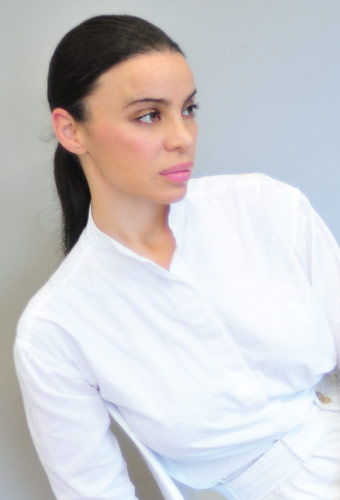A chat with Tia Cibani of Tia Cibani Kids.
Born in Libya and raised in Canada, Tia Cibani continued her worldly lifestyle by spending much of her adult life as a fashion designer in China. In 2004, she was tapped as creative director of Ports 1961 where she led the design team, oversaw a major retail expansion and became a red-carpet darling in Hollywood. She went on to introduce her own namesake line in 2012, soon hailed by Style.com, Vogue Italia and WWD as a designer to watch. However, despite her growing recognition in womenswear, Cibani found her heart and soul in the children’s market after the birth of her two children. In 2014, Cibani refocused on a new fashion venture beneficial to her son and daughter. Enter Tia Cibani Kids.
Now, ensconced on a 20-acre property in North Salem in Westchester County, N.Y., Cibani believes she has finally found her calling. Managing a small team, including designers, sales and marketing executives, who happily make the trek to her suburban home, Cibani enjoys the balance of growing her business and spending time with her children. “The industry appreciates what I’m doing and that feed me,” she says. “I find childrenswear has light, innocence and humor. You can’t be grumpy designing for kids.” –Kristin Young
What is your design philosophy for childrenswear? I love beautiful things that are innovative, but most importantly, it needs to be functional for kids. The marriage of beauty, innovation and function is key to my design. It’s all about the balance of texture, color, details and construction that makes for an interesting garment or piece of art. I’m always subconsciously thinking about it being functional.
Did you have any experience in childrenswear prior to going off on your own? While I was doing Ports 1961, I had a childrenswear line, Kicokids. It became my hobby on the side. I didn’t need it to succeed, but it naturally started to take off. However, after the birth of my first daughter, I decided to leave Ports because of all the travel. I went back to womenswear for a short time with my own collection, but it was way too much stress. Kids was much easier to fall back on.
Do you ever dabble in womenswear today? A little bit to complement my collection. I’m really happy to stay away from womenswear. My little fix is a few mommy pieces.
Where do you get your inspiration? I draw from my personal heritage and global exposure and experiences for inspiration. I love diversity and the clash of cultures. I often get ideas from North African culture—the souks, the region’s eclecticism, the colors, the details and the baubles.
Who is your core customer? Global, artsy parents who love beautiful things and seek inventive design. My customers see the value in dressing their kids in [high-end] fabrics and clothing. I think many parents see the value in exposing their children to that level of excellence, as much as they would an interesting building. Dressing them in something that was made with integrity and beautiful fabric has to affect children.
Describe the elements of your fall collection. Masterful color combinations, naïve art, cubist patterns, unexpected stripes, sportive outdoor, moccasin-inspired accessories, perched hats, fringe, shearling and handwoven textures. Price points at retail range from $130 dresses to $200 coats.
Anything in the pipeline for coming seasons? We are expanding to include more baby offerings, gift items and accessories. We are developing a special baby travel kit for families on-the-go, to be unveiled for SS ’18. The kit is made from 100-percent organic cotton and contains a basic one-piece, a pair of footed leggings, a burpie, a travel blanket and a cap, all contained in a pouch in our signature tyvek polka-dots print that converts into a diaper-changing pad. The sizes will range from 3 months to 12 months. We’ve been asked time and time again, but I was always hesistant about venturing into babywear. You must be so aware of safety. With baby, there’s no messing around. Although I was intimidated at first, now I feel more comfortable.
What would you pinpoint as your design signature? Color, color, color! I’ve never done anything in black. I just can’t see children in black clothes. I enjoy combining unexpected colors, modern inventive playful designs with subtle ethnic touches such as tassels, pompoms and wooden beads. We offer endless options of fantastic skirts and dresses. Relaxed shapes and unique prints developed in-house with hand-painted effects are also important signatures of our collection. I love colorful pieces of art, even color that seems a little aged and worn and that has lived a little bit. The clothes have to be playful and humorous.
Do you get any feedback from your kids?
When in doubt, my little girl gives me the seal of approval. For instance, we were developing one print, some with a neon colors and others with pastels. She went straight to the pastel.
What is the biggest challenge facing designers today? The climate is not good. Designer kidswear is still mostly sold by small boutiques. You don’t go to the department stores for that because it’s not well-curated. They don’t take it as seriously, and that’s the blessing of kidswear in this difficult climate. We are still relying on small boutiques because they are important to the industry. Honestly, I don’t feel as worried now as I did four years ago when I was in the women’s market.
What have you learned designing for children? For children, function comes first. The garment must be comfortable and easy to wear, easy to move in. Women are willing to suffer for a look, but children would never put up with an itchy sweater just because it is the latest trend.




Leave a Comment: